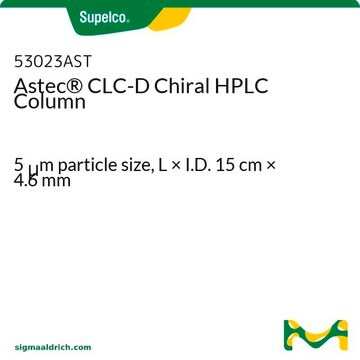11018AST
Astec® CHIROBIOTIC® V Chiral (5 μm) HPLC Columns
L × I.D. 10 cm × 2.1 mm, HPLC Column
Sign Into View Organizational & Contract Pricing
All Photos(1)
About This Item
UNSPSC Code:
41115700
eCl@ss:
32110501
NACRES:
SB.52
Recommended Products
product name
Astec® CHIROBIOTIC® V Chiral HPLC Column, 5 μm particle size, L × I.D. 10 cm × 2.1 mm
material
stainless steel column
Quality Level
agency
suitable for USP L88
description
HPLC Column
product line
Astec®
packaging
pkg of 1 ea
manufacturer/tradename
Astec®
parameter
0-45 °C temperature
241 bar pressure (3500 psi)
technique(s)
HPLC: suitable
LC/MS: suitable
L × I.D.
10 cm × 2.1 mm
matrix
High-purity silica gel particle platform
fully porous particle
matrix active group
vancomycin phase
particle size
5 μm
pore size
100 Å
operating pH range
3.5-7.0
separation technique
chiral
Looking for similar products? Visit Product Comparison Guide
General description
Neutral molecules, amides, acids, esters and amines show considerable enantioselectivity on these vancomycin-based CSPs. A wide variety of secondary and tertiary amines have been separated on the CHIROBIOTIC® V in the polar ionic mode. The CHIROBIOTIC® V has demonstrated many of the separation characteristics of protein-based stationary phases, but with exceptional stability and much higher sample capacity. Some chiral analytes have been resolved that have not been reported separated on any other chiral stationary phase. CHIROBIOTIC® V and V2 differ in their bonding chemistry the pore size of the support particle, giving them different selectivity and preparative capacity.
- Bonded phase: Vancomycin
- Operating pH range: 3.5 - 7.0
- Particle diameter: 5, 10 or 16 μm
- Pore size: 100 Å (CHIROBIOTIC® V) or 200 Å (CHIROBIOTIC® V2)
Legal Information
Astec is a registered trademark of Merck KGaA, Darmstadt, Germany
CHIROBIOTIC is a registered trademark of Sigma-Aldrich Co. LLC
Choose from one of the most recent versions:
Already Own This Product?
Find documentation for the products that you have recently purchased in the Document Library.
Sherri L MacLeod et al.
Journal of chromatography. A, 1170(1-2), 23-33 (2007-10-05)
A reversed-phase enantioselective liquid chromatography-tandem mass spectrometry (HPLC-MS-MS) method was developed to measure enantiomer fractions (EF) and concentrations of pharmaceuticals in wastewater. Enantiomer resolution of six beta-blockers (atenolol, metoprolol, nadolol, pindolol, propranolol, and sotalol) along with two selective serotonin re-uptake
Ana R Ribeiro et al.
Chemosphere, 95, 589-596 (2013-11-05)
Microbial degradation is the most important process to remove organic pollutants in Waste Water Treatment Plants. Regarding chiral compounds this process is normally enantioselective and needs the suitable analytical methodology to follow the removal of both enantiomers in an accurate
Enantiomeric separation of mirtazapine and its metabolite in rat plasma by reverse polar ionic liquid chromatography using fluorescence and polarimetric detectors connected in series
Rao, R. Nageswara, et al.
Journal of Chromatography. B, Biomedical Sciences and Applications, 879 (21), 1911-1916 (2011)
Chiral stability-indicating HPLC method for analysis of arotinolol in pharmaceutical formulation and human plasma
Sultan, Maha A., et al.
Arabian Journal of Chemistry, 3 (3), 147-153 (2010)
Hisham Hashem et al.
Journal of chromatography. A, 1218(38), 6727-6731 (2011-08-23)
In this study, a method for enantioseparation of terbutaline and salbutamol was established using Chirobiotic V column as a stationary phase. Polar ionic mode applying mobile phase containing ammonium nitrate in 100% ethanol, pH 5.1 was found to give the
Our team of scientists has experience in all areas of research including Life Science, Material Science, Chemical Synthesis, Chromatography, Analytical and many others.
Contact Technical Service





